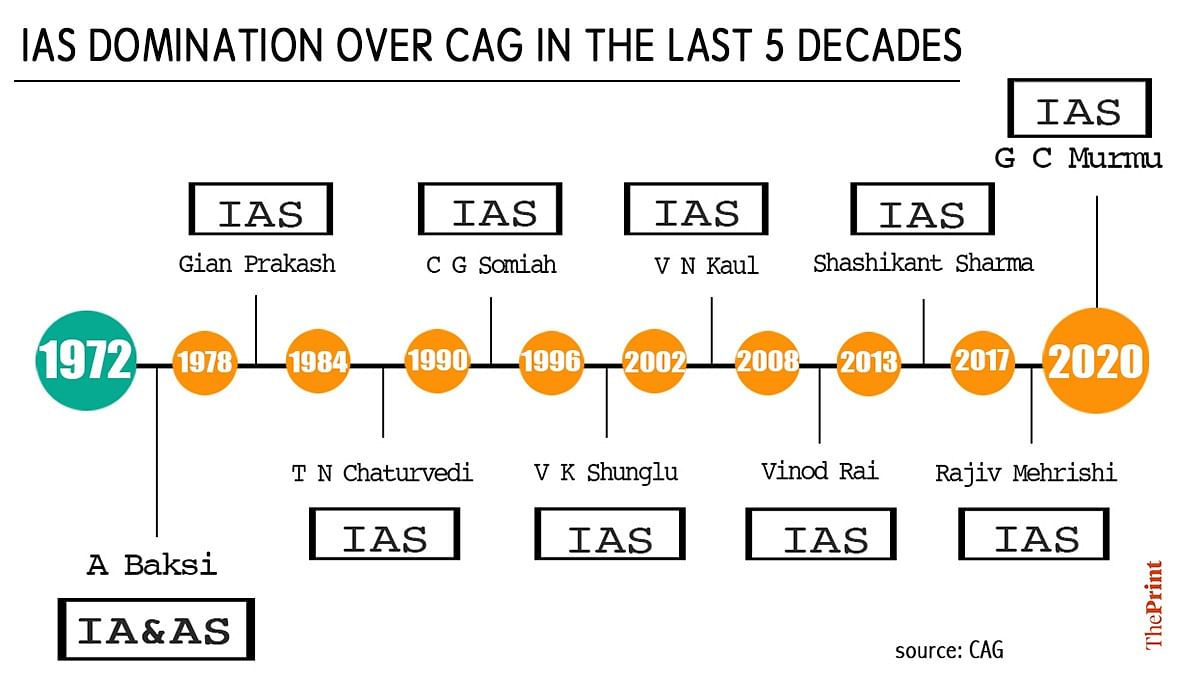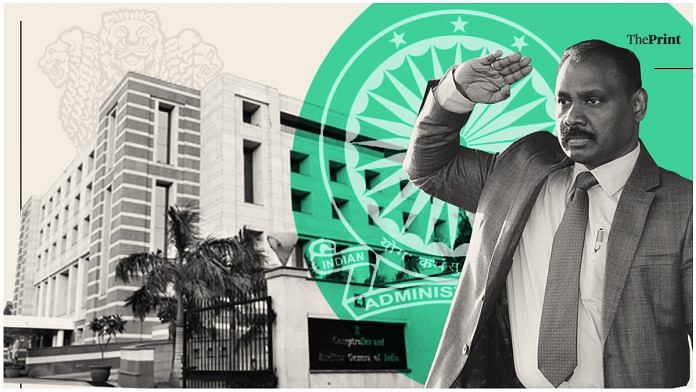New Delhi: The appointment of Jammu and Kashmir’s former lieutenant governor G.C. Murmu, a 1985-batch Gujarat cadre Indian Administrative Service (IAS) officer, as the Comptroller and Auditor General (CAG) has brought the discontent among the Indian Audit and Accounts Service (IA&AS) officers to the surface.
The move is just the latest instance of the IAS domination over the top IA&AS post, serving officers in the latter’s cadre told ThePrint, pointing out that Murmu, who took voluntary retirement last year to go to J&K, superseded around half a dozen IA&AS officers to take the position.
These include three officers from the 1983 batch — deputy CAG V. Ravindran and Roy S. Mathrani, and Sudha Krishnan, who is on deputation to the Space Commission.
Murmu also superseded three officers from the IA&AS 1984 batch — deputy CAG Meenakshi Gupta and Saroj Punhani, and Gargi Kaul, who is on deputation to the defence ministry.
“There has been no precedent like this in our service where a CAG has been appointed after superseding so many senior officers, including those on deputation,” said a senior IA&AS officer.
A second officer pointed out, “There is a direct jump of seven years this time around which is causing angst.”
The last CAG, Rajiv Mehrishi, who was appointed in 2017, was from the 1978 IAS cadre, while his predecessor Shashikant Sharma was a 1976 batch officer, said the officer.
The officer highlighted the previous instance of supersession when Vinod Rai, a 1972-batch IAS, was appointed the CAG. He had superseded a 1971-batch IA&AS officer, Bharti Prasad, who was the deputy CAG. “She continued working under Rai till she retired,” the officer said.
The officer added that it’s rare for IA&AS officers to work under a batchmate.
“Generally if somebody is appointed as CAG, IA&AS officers from the same batch are sent outside on deputation. However, in the last one or two years, there have been instances where officers from the same batch have agreed to work under CAG to avoid being transferred out of Delhi,” the officer said.
According to the officers ThePrint spoke to, there are four serving IA&AS officers from the 1985 batch to which Murmu belongs.
Also read: Why Modi govt chose trusted BJP leader Manoj Sinha to replace IAS veteran Murmu as J&K L-G
The IAS domination
Since independence, India has had 14 auditor generals. The first three CAGs were from the IA&AS. Then an Indian Civil Service officer was appointed. The last IA&AS officer to have held the post was A. Baksi, who served between 1972 and 1978.
His next nine successors were from the IAS cadres.

This continued domination of the IAS over decades has angered IA&AS officers, with some individual officers in the past even considering knocking the court’s door.
But now, most of the cadre officers have reconciled themselves to this.
“So much so that normal aspiration of an IA&AS officer is limited to becoming deputy CAG… Because he or she knows that a CAG will be from the IAS. That has been the trend since all these years,” said one of the officers quoted above.
Also read: 50% IAS, IFS recruits are children of govt servants. But this is a story of their merit
Why IAS wins over the IA&AS
One of the reasons behind the IAS dominance is that unlike IA&AS, these officers frequently interact with the government, ministers and even the prime minister, said the officer.
“So there is a familiarity. An officer can get close to the ruling dispensation and can end up being the preferred choice for a particular post,” the officer said.
The IA&AS officers are the quintessential faceless civil servants, unlike the IAS, said the officer. “We rarely interact with government ministers. We work through our reports.”
Murmu, a Gujarat-cadre IAS officer, is seen as a confidant of Prime Minister Narendra Modi and Home Minister Amit Shah, having worked closely with them in the state government of Gujarat.
After Modi became PM, Murmu was brought to the Centre. He held senior positions in the Department of Financial Services and Department of Revenue before being appointed as expenditure secretary.
In a surprise move last year, Murmu was named the first L-G of the Union Territory of Jammu and Kashmir after the erstwhile state’s bifurcation in August.
Anupam Kulshreshtha, an IA&AS officer who retired as deputy CAG in 2012, said the auditor general is a constitutional post and it is the government’s prerogative to appoint whoever they find suitable.
“But the appointment process should be transparent. There is conflict of interest in the current process where the PM, as the head of executive, selects a person to be appointed as the CAG. To avoid such conflict, the government can set up a search-cum-selection committee on the lines of CVC and CIC, which may include the leader of opposition, Supreme Court judge, etc. among its members,” said Kulshreshtha.
However, a serving IAS officer pointed out that the appointment of an officer from the cadre provides a balancing act.
“Most of the officials in the CAG are from the audit side. An official from the IAS is better placed to understand the views of other ministries and departments and acts as the balancing figure between the auditors and other government departments,” he said.
The CAG’s significance
The Comptroller and Auditor General of India, referred to as ‘auditors to the nation’, is a financial watchdog that closely monitors all government revenues and expenditures and their adherence to existent laws.
It is seen as an all-powerful agency with its reports having the potential to embarrass or bring down governments.
For instance, a report prepared by then CAG T.N. Chaturvedi in 1989 on irregularities in purchase of howitzer guns, with a specific mention of Swedish arms manufacturer Bofors, led to the collapse of the Rajiv Gandhi government.
Similarly, the 2G report under Vinod Rai became a huge embarrassment for the Manmohan Singh government, leading to policy paralysis and allegations of corruption that ultimately resulted in the government being voted out of power in 2014.
Also read: Nothing wrong with cut-offs for EWS candidates being lower than SC, ST & OBC, says UPSC



